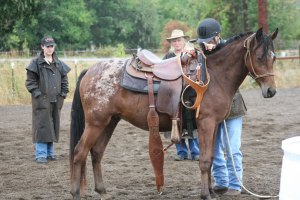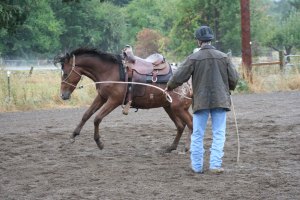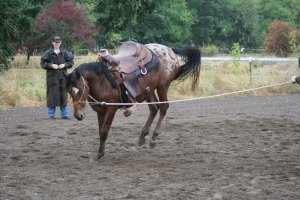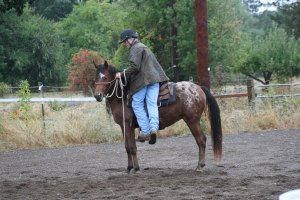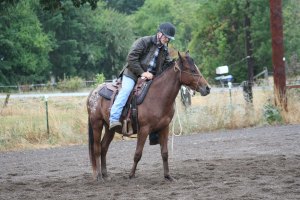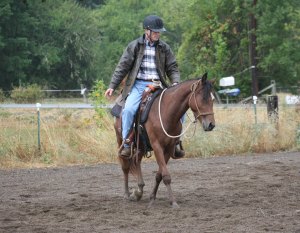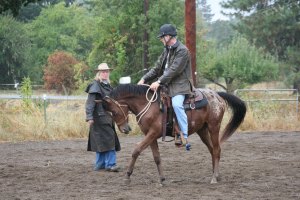Before There Were Fences
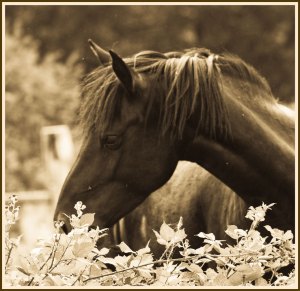
The American West has two icons: wild horses and fences. The stories of our nation’s movement East to West are filled with both. The issues our nation’s wild horses face today are wrapped in arguably around the invention of barbed wire; a cheap and effective way to create a boundary to trap or protect resources. Before the invention of barbed wire, fences were built of wood or stone. As our nation expanded westward, fence-building materials were heavy, expensive, and in limited supply to transport. Single wire fences could be easily ignored. With the twist of two wires together came a strong, cheap, formidable boundary forever changing the American landscape and allowing the expansion of farming and ranching practices as well as the number of people who could settle an area. Harnessing resources set the stage for battles over the question land use. And for the wild horses, the barbed wire fence created the ability to ask the question of who shall live where and in what kind of quantities?
In an article titled. “Bringing Home All The Pretty Horses”, Dan Flores describes how an earlier settler named Audobon felt about the discovery of the wild horses. In his article, a wild horse named “Barro” is described in the following way:
” He had a sweet gait that covered forty miles a day. He leapt over woodland logs “as lightly as an elk,” was duly cautious yet a quick study in new situations, and was strong and fearless when coaxed to swim the Ohio River. He was steady when birds flushed and when Audubon shot them from the saddle. And he left a “superb” horse valued at three hundred dollars in the dust. Audubon quickly bought Barro for fifty dollars silver and, gloating over his discovery, concluded that “the importation of horses of this kind from the Western Prairies might improve our breeds generally.”
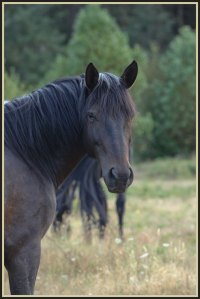 Unfortunately for today’s Mustangs, we rarely find people looking to cross the Ohio River or travel 40 miles per day by horse.
Unfortunately for today’s Mustangs, we rarely find people looking to cross the Ohio River or travel 40 miles per day by horse.
In 1971, the Wild Free Roaming Horses and Burros Act was created. The act addressed a horrific situation brought to the forefront of public attention by Velma B. Johnson, better known as “Wild Horse Annie”. In the 1950’s wild horses were being ruthlessly and inhumanely gathered by ranchers, hunters, and “mustangers” and subsequently harvested for commercial gain. By 1971 the harvesting of Mustangs and the spread of the human population had drastically reduced the number of wild horses. In response to public outcry, Congress unanimously passed a bill to protect wild horses and burros. The act gives the Bureau of Land Management (BLM) jurisdiction over the wild horses. Since the BLM is the government body that is in charge of protecting public lands, it seemed appropriate that they govern the horses that live on those lands. The BLM is tasked with determining how many horses can be supported by the land they live on and then gathering/rounding up the excess horses, with the goal being to maintain the balance of horses to land resources.
According to the BLM website, “The BLM protects, manages, and controls wild horses and burros to ensure that healthy herds thrive on healthy rangelands. If an overpopulation of wild horses and burros exists on public lands, the BLM gathers excess animals and offers them to the general public for adoption. The BLM presents these animals at adoption events and at BLM facilities throughout the United States. In addition to placing wild horses and burros into good homes through the adoption program, the BLM has direct sale authority that allows the agency to directly sell animals that are more than 10 years old and those younger that have been passed over for adoption at least three times. “
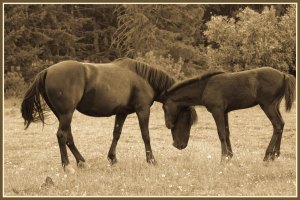
In 2005, Ford Motor Company and Take Pride in America, partnered to establish the “Save The Mustang Fund” . The goal of this partnership is to build public awareness for the plight of America’s wild horses. The programs activities include providing money to non-profit organizations able to provide homes for older Mustangs, sponsor clinics put on by local equine groups to educate local communities, build relationships with collegiate programs with gentling Mustangs as part of their equine studies programs, and become involved with the “Extreme Mustang Make Over “ event. An event designed to highlight Mustang training at a national level and raise public awareness.
With all these good intentions and monies pointed towards protecting our wild horses, how do Mustangs end up in local horse rescue situations? Why are they not protected or cared for in another way? The answer lies with the sale of a wild horse. Once a horse is sold, the BLM steps out of the equation, even if the approved home turns out to be unacceptable, the sanctuary where the horse was sent implodes, or the Extreme Mustang Makeover fails.
At Emerald Valley Equine Assistance/Horse Rescue (EVEA), I met a Mustang mare named Hailey, her 4 month old foal, Rugar, and a Mustang gelding named Ronin. All three of these horses found themselves in the care of our local horse rescue after being placed in adoptive situations. Now they find themselves no longer in the situation where they were originally placed. The irony for these Mustangs, they were originally moved from their homelands to avoid an out of balance situation, yet that is where they ended up.
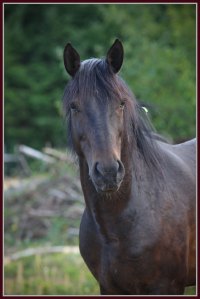 Hailey is a Sheldon Mustang. She was originally from Nevada and part of a herd managed by the Nevada Fish and Wildlife. Hailey was sent to what was supposed to be a horse sanctuary in Alliance, Nebraska. Everyone expected 3-Strikes Ranch to be her “forever” home. A place that was supposed to be a “Mustang Outpost, Helping Horses” according to it’s reputation. It was supposed to be a place where horses could roam free on a sprawling 1900 acre ranch with an abundance of grazing land. And apparently, for a while, it was a sanctuary. People paid the operators of the facility $500 to take their horses and give them a good life. It was a non-profit organization. But something started to go very wrong and the situation had turned tragic. Even now, nobody seems to understand what events transpired to change everything. Through the efforts of neighbors, Internet chatter, local officials, Habitat for Horses, and others, authorities were able to get onto the property to assess the horrific details of the situation. The owner of the facility had to be convinced to legally release the horses to these organizations in order to get the horses the help they needed. Criminal charges were brought against the operator of the ranch. What events could have transpired that would cause a once healthy environment to become a death trap? Hailey was removed from her wild environment to maintain ecological balance and ended up in a situation where she was starving. She made it out of the situation alive, but pregnant. The refuge where she originally came from didn’t take her back. Hailey and another Sheldon Mustang mare came to Oregon. EVEA paid to have the horses shipped to them. At the time of transport, nobody knew that really three horses had arrived.
Hailey is a Sheldon Mustang. She was originally from Nevada and part of a herd managed by the Nevada Fish and Wildlife. Hailey was sent to what was supposed to be a horse sanctuary in Alliance, Nebraska. Everyone expected 3-Strikes Ranch to be her “forever” home. A place that was supposed to be a “Mustang Outpost, Helping Horses” according to it’s reputation. It was supposed to be a place where horses could roam free on a sprawling 1900 acre ranch with an abundance of grazing land. And apparently, for a while, it was a sanctuary. People paid the operators of the facility $500 to take their horses and give them a good life. It was a non-profit organization. But something started to go very wrong and the situation had turned tragic. Even now, nobody seems to understand what events transpired to change everything. Through the efforts of neighbors, Internet chatter, local officials, Habitat for Horses, and others, authorities were able to get onto the property to assess the horrific details of the situation. The owner of the facility had to be convinced to legally release the horses to these organizations in order to get the horses the help they needed. Criminal charges were brought against the operator of the ranch. What events could have transpired that would cause a once healthy environment to become a death trap? Hailey was removed from her wild environment to maintain ecological balance and ended up in a situation where she was starving. She made it out of the situation alive, but pregnant. The refuge where she originally came from didn’t take her back. Hailey and another Sheldon Mustang mare came to Oregon. EVEA paid to have the horses shipped to them. At the time of transport, nobody knew that really three horses had arrived.
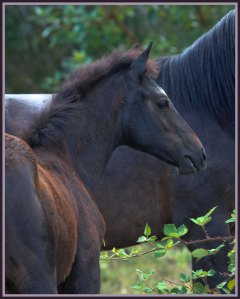
Rugar was born 4 months ago. His paternity is completely unknown, but the situation he was conceived in could not have been good. He was not an easy delivery. When he finally arrived, he was born with an “extra” hoof growing out of his right front hoof. Surgery was required to fix the condition. Rugar survived the surgery and is able to walk, trot, and canter about the pasture with his mom and the other horses. But it is questionable if he will ever be able to be ridden. Chances are he will be in the care of horse rescue his entire life unless he finds someone willing to take a chance on him. Nobody really knows what the future could hold for him.
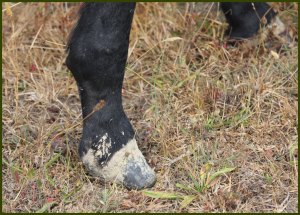
Gentling and training a wild horse is not quick and easy task. All to often, the horse is being asked to transform from a being able to survive by its wits to a horse with relatively little to do and not much space to do it in. People underestimate what the stress of being confined, even in what they consider a large space, is like for an animal that has roamed freely. And frequently the expectation is that the transformation can happen quickly. Ironic, since change is usually so hard for people.
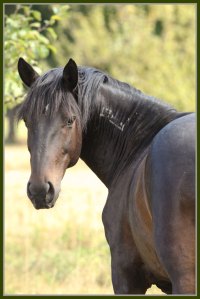 Ronin is a 5 year old Mustang gelding who participated in the Mustang Makeover event a couple of years ago. His make over did not go well. While it is possible for some horses to adapt to the intense learning environment created in a time trial training event, as with people, not all individuals can handle an accelerated learning program. It was too much for Ronin. He is a very amiable character on the ground, very personable and easy to handle. But get out a saddle, and Ronin shows his fear. He bucks to save his life, so to speak. So where does the responsibility for Ronin’s care lie now? The BLM wont take him back, the trainer who participated in the event doesn’t want him, so he finds himself in a horse rescue situation. And who will want to adopt him? He is beautiful, graceful, personable, but not prone to being ridden.
Ronin is a 5 year old Mustang gelding who participated in the Mustang Makeover event a couple of years ago. His make over did not go well. While it is possible for some horses to adapt to the intense learning environment created in a time trial training event, as with people, not all individuals can handle an accelerated learning program. It was too much for Ronin. He is a very amiable character on the ground, very personable and easy to handle. But get out a saddle, and Ronin shows his fear. He bucks to save his life, so to speak. So where does the responsibility for Ronin’s care lie now? The BLM wont take him back, the trainer who participated in the event doesn’t want him, so he finds himself in a horse rescue situation. And who will want to adopt him? He is beautiful, graceful, personable, but not prone to being ridden.
Each of the horses featured in this story was part of a good idea. Someone had a plan that seemed like it would work. A forever sanctuary for Mustangs was/is a good idea. Why didn’t it work? There are plenty of guesses, nobody really knows. Saving the life of Rugar, who was bred from a disastrous situation, another idea that seems right. Trying to raise awareness about Mustangs and gain national attention through a major media event like the Mustang Makeover seems to be a good idea for getting people to participate in the adoption process. When it comes to our wild horses, there are a lot of good ideas, intentions, and opinions. The problem? What happens when the horses fall through the crack of a good idea?
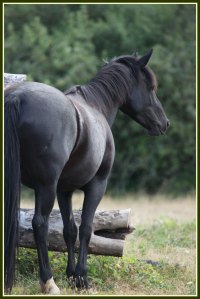
Americans can get very passionate about wild horses. Wild horses have a long history in our country. Even today, on games like “Farmville” people spend hundreds of virtual hours interacting with horses. The land use topics that are raised around planning for the care of our nation’s wild horses bring up issues people do not want to face. Imagine if people were subject to density ratios. What if our cities and spaces were set up the same way…? Only predetermined amount to people could live in a given location, even if your family had lived there for decades. If the population grew too much, too many babies were born and not enough of the elderly passed on, you would have to be relocated. Housed in a holding facility until a suitable place could be found for you. Waiting for someone to take you in. People would never stand for such conditions, yet that is what happens for wild horses.
In 2000, I adopted a Mustang from the BLM. Since then I have had the opportunity to experience many Mustang related training events and spend hours interacting with my horse as he adapted to the would we share. My horse has taught me more about diversity, culture, and expectations than I could have imagined. I remember when I thought all horses would know what a carrot was…a fine treat I brought to offer my new friend. My horse ran as far away from me as he could get, never having seen a carrot, he did not know what to expect. Through my Mustang, I have learned more about the world I live in than if I had spent months traveling. I have come to care about our lands and its uses in ways that would have never noticed in the past.
In my experience, when you adopt a BLM Mustang, the world expects you to be an expert in the issues facing the wild horses and that you have an opinion as to what should happen. I didn’t adopt my horse to save the world or come up with all the answers to a very large issue. I did adopt him because if I didn’t, he was going back to a holding pen and an unsure future. I don’t know if the BLM should stop rounding up horses. I do think there should be a better plan in place if they are going to continue the process. I do think starvation is horrible state to live in, whether in the wild or in private. I do think that the BLM has a responsibility to the horses they adopt out if the situation goes astray. I do think that people need to get involved in finding a solution. Right now the BLM is in the process of developing a new plan for dealing with our nation’s wild horses. I do think that it is once again time for a national outcry and the BLM seems ready to listen. This year, 2010, is the year the BLM is taking input from the public and trying to come up with a better direction. I think people should click on this link to follow the BLM and become concerned advisers to the plan, whatever you opinion. I do think that if everyone who played “Farmville” and enjoyed hours of virtual entertainment from interacting with horses and other farm life adventures gave a dollar to the BLM or a local horse rescue, there would be a lot more money to support the animals in need. Hailey, Rugar, and Ronin would have secure futures.
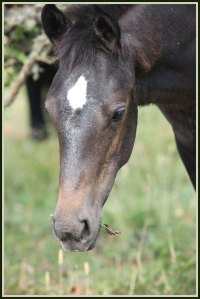
It is often easier to become outraged by injustice half a world away
than by oppression and discrimination half a block from home.
~Carl T. Rowan
Special thanks to Sandy Huey at EVEA for taking the time from her busy schedule to take me out to meet the horses featured in this story. This woman does amazing things!

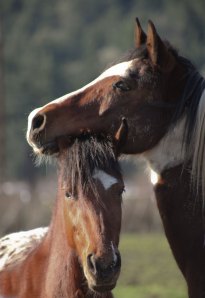
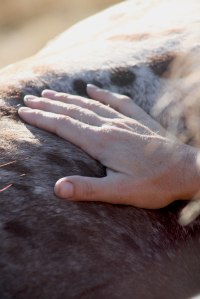
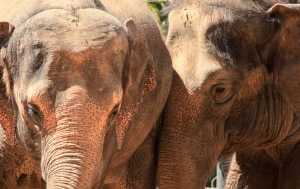
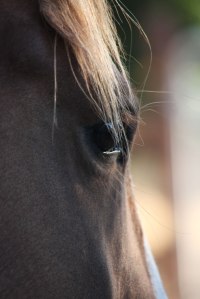
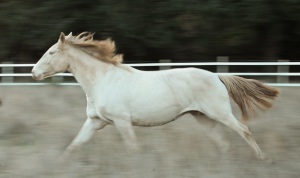

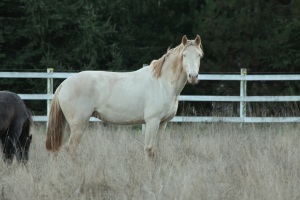
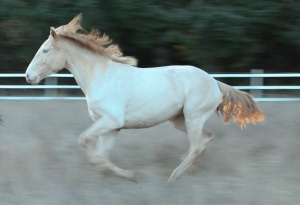

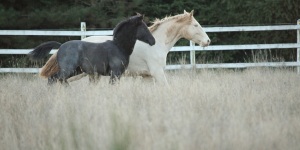










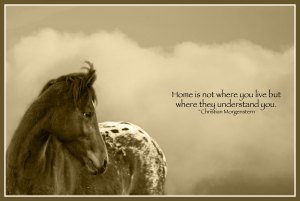
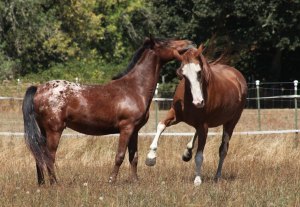
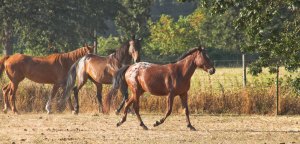


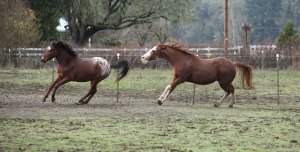
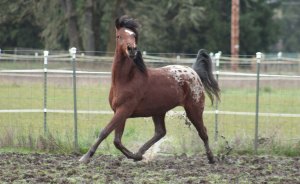

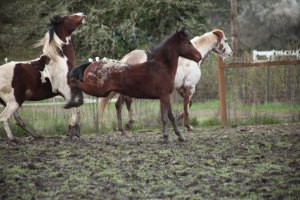

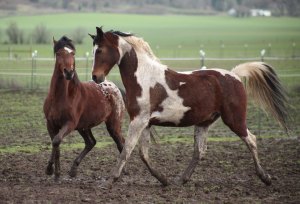

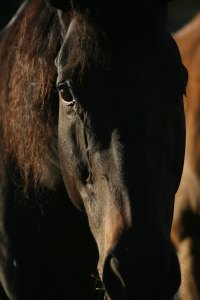

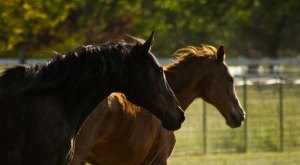

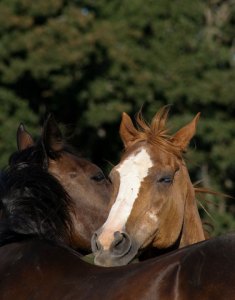
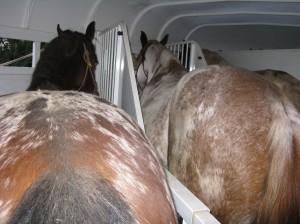

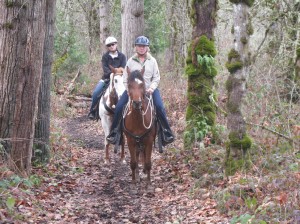
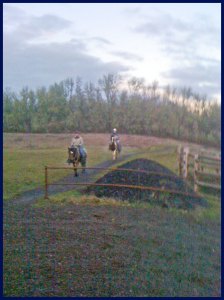


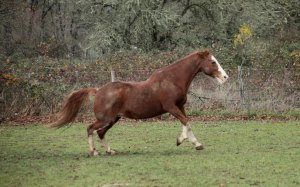
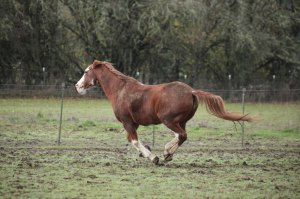

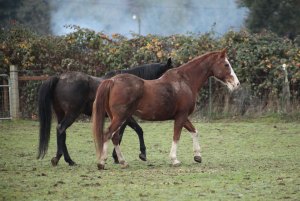
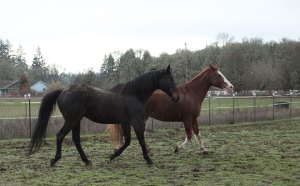
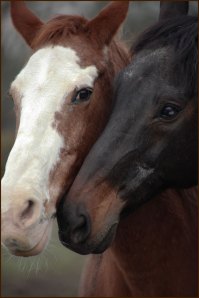
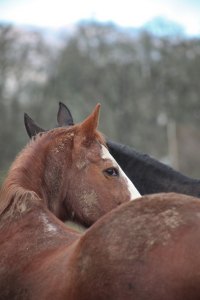
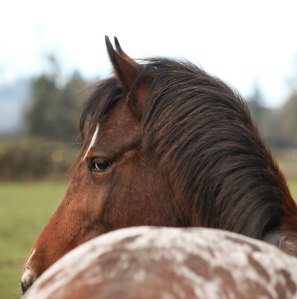
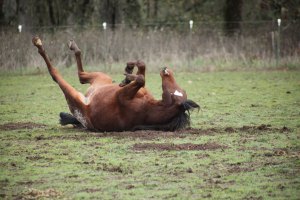
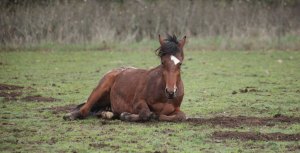

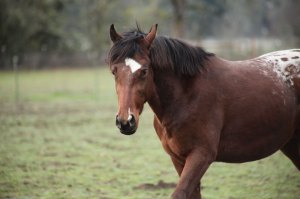
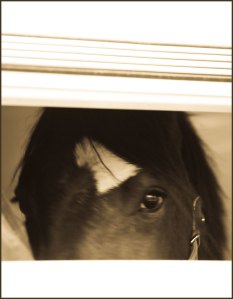
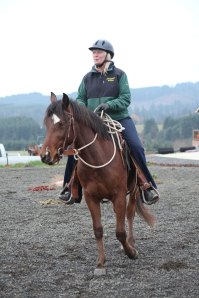
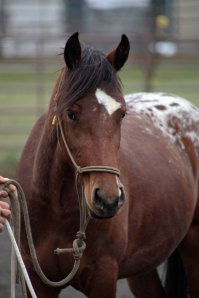 Picasso Moon has been busy this past month. He went off to boarding school with Dave, his trainer. What a star he has been. Dave says a trainer rarely gets a chance work with a horse like this because he is so easy and fun that usually people try to start the horse on their own. From my perspective, a horse like Picasso Moon needed a great start from someone who would appreciate him and set a solid foundation on which to build.
Picasso Moon has been busy this past month. He went off to boarding school with Dave, his trainer. What a star he has been. Dave says a trainer rarely gets a chance work with a horse like this because he is so easy and fun that usually people try to start the horse on their own. From my perspective, a horse like Picasso Moon needed a great start from someone who would appreciate him and set a solid foundation on which to build.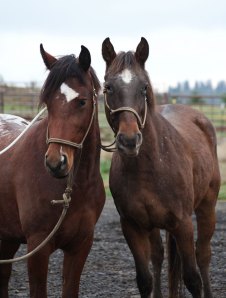
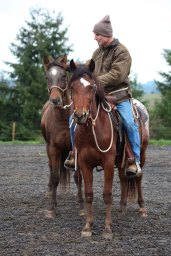 place. He liked that job very much. So when Trinity arrived at Dave’s Picasso Moon was all set to show off to his big sister. So Dave saddled up Picasso Moon and they got ready to take Trinity for a walk around the place. It was great to see Picasso Moon so confident and calm about doing whatever he was asked to do. He is a very sure-footed horse. The terrain they walked on included gravel, roads, and some hill climbing. Picasso Moons just takes his time and decides the best route to take.
place. He liked that job very much. So when Trinity arrived at Dave’s Picasso Moon was all set to show off to his big sister. So Dave saddled up Picasso Moon and they got ready to take Trinity for a walk around the place. It was great to see Picasso Moon so confident and calm about doing whatever he was asked to do. He is a very sure-footed horse. The terrain they walked on included gravel, roads, and some hill climbing. Picasso Moons just takes his time and decides the best route to take.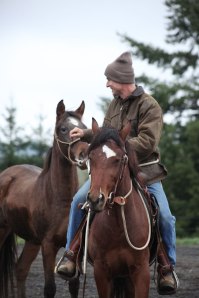
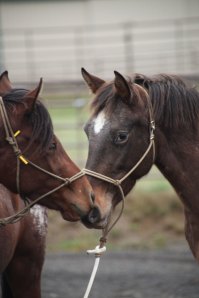
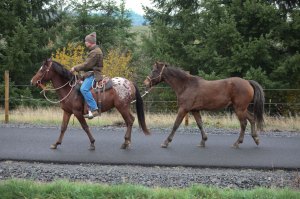
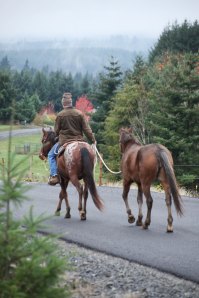
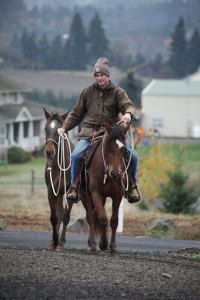
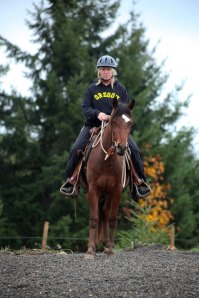
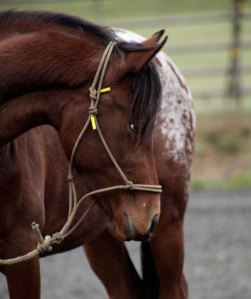
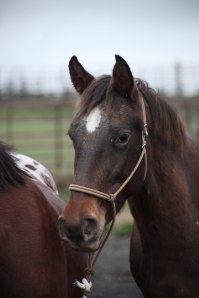
 Picasso’s First Rider
Picasso’s First Rider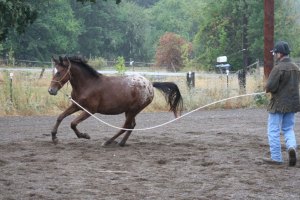 gh our lead rope activities. One could argue that being chased around the pasture is moving off the feeling of energy, so he already knew that coming into the training process. So what is the difference? In my mind, nothing. Training is about channeling his horse knowledge into behaviors that suit human purposes and create an environment that is safe for both horse and human to interact in.
gh our lead rope activities. One could argue that being chased around the pasture is moving off the feeling of energy, so he already knew that coming into the training process. So what is the difference? In my mind, nothing. Training is about channeling his horse knowledge into behaviors that suit human purposes and create an environment that is safe for both horse and human to interact in.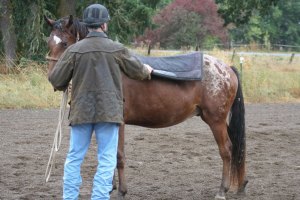
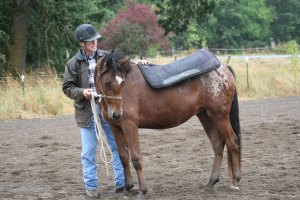 Not such a big deal… Picasso checks things out from another angle.
Not such a big deal… Picasso checks things out from another angle.